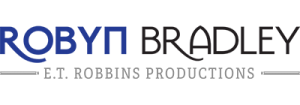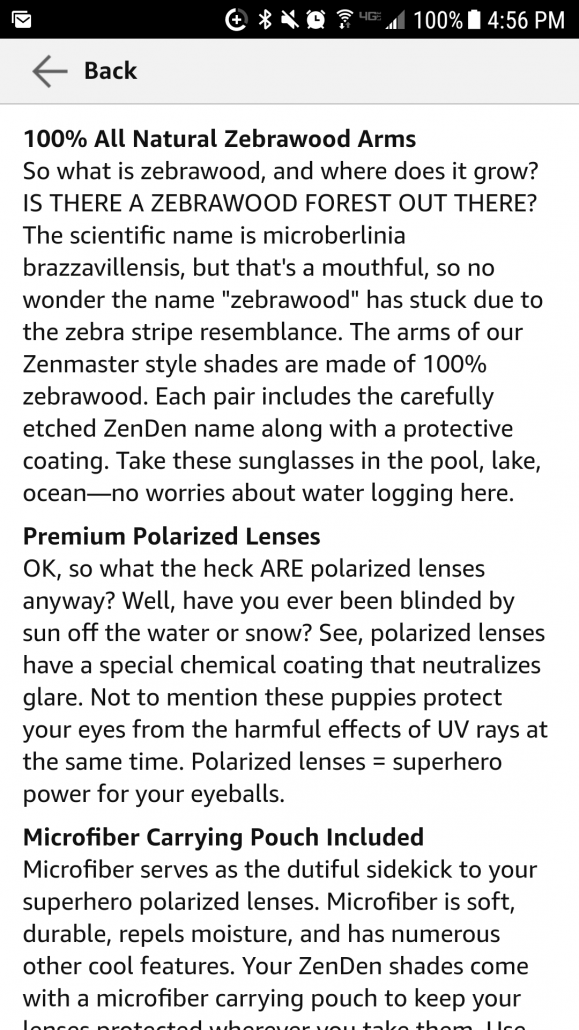What is Freelance Copywriting in 2025? Here’s the Unvarnished Truth.
OK, it’s time for my straightforward explanation of freelance copywriting based on my 22 years working as a freelance copywriter. Below, I begin by answering the burning question, “What is freelance copywriting?” But I also answer related questions.
What follows is my own unvarnished truth. Do I know everything there is to know about copywriting? Absolutely not. But I’m tired of all the rah-rah gurus claiming people can make six figures with zero experience after taking one course.
There’s nothing wrong with pursuing six figures. There’s nothing wrong with educating yourself by taking courses (with a few caveats, which I’ll get into below).
But there’s nothing saying you must make six figures—or that you will, even if you’re good. (Or that you’ll be happy if you do.) And there’s nothing saying you need a copywriting degree to become a copywriter.
Everything you need to know about copywriting you can learn online for free.
Yes, really. I’m living proof.
So this is (the beginning) of my attempt to set the record straight about copywriting, what it means to “be” a copywriter, and how to get started in copywriting.
If you want to jump to a specific section, I’ve created jump links in the list below for easy navigation.
- What is freelance copywriting?
- Are copywriting and content writing the same thing?
- How the digital era affected writing
- Understanding how copywriting works
- Understanding what copywriters do
- Where do copywriters work?
- How much do copywriters make?
- Is it hard to become a copywriter?
- How to get into copywriting
- How is AI affecting the copywriting landscape?
- How to get copywriting clients
What is freelance copywriting?
To define freelance copywriting, we first have to define copywriting. Simply put, copywriting involves coming up with the words that sell stuff. And by “stuff,” I mean products (like Doritos, solar panels, nail polish), services (landscaping, HVAC maintenance, bat removal), and causes (politicians, nonprofits, blood donation).
The words must inspire action. The words must persuade. But before they can do either, the words must get noticed and resonate with whoever’s doing the noticing. In other words, the copy must engage.
That last line about how the copy must engage will ruffle some feathers, which I’ll address in a moment.
As for freelance copywriting . . . that simply means the person doing the writing isn’t an employee. They’re a freelancer who’s been contracted to write the website, marketing brochure, print ad, social media posts, video scripts, radio spot . . . you get the idea.
Are copywriting and content writing the same thing?
To answer this question, I need to provide some context—and a little history.
Forty years ago, content writing and content marketing didn’t exist. Those things came about once the online world took hold. Copywriters, however, did exist. (Think advertising copywriters like Peggy from Mad Men.) And direct mail copywriters. (You probably still get those long sales letters pitching you something.) And radio and TV commercial copywriters.
Copywriters wrote the words that drove people to buy stuff (products, services, causes). Good copywriters from yesteryear knew how to capture their audience’s attention and how to get them to act.
And that’s how it was until the 90s when the digital era dawned.
How the digital era affected writing
As more businesses developed their online presence (starting with a website), they realized they needed good content to attract visitors, engage them, and eventually convert them to sales.
Someone needed to write this online content, and those who did began calling themselves content writers and content marketers.
Where did that leave copywriters?
Many copywriters didn’t miss a beat. They recognized that content is content, and the label you call yourself is irrelevant.
The thing these old-time copywriters did have to learn was how online content works. When a copywriter writes an ad, they’re writing to sell. But with online content, you often take a few steps back before you get to that point. Some content (for example, blog posts like the one you’re reading right now) is more about educating people, while some content is more about selling.
Is there a reason why a copywriter of yore can’t write content that engages or educates instead of sells? Nope. Not unless the copywriter gets hung up on titles and semantics.
That’s why many people, including me, use the terms copywriter and content writer interchangeably.
Cue the cranky critics who insist copywriting and content writing are different animals.
Yep, the purists will tell you that copywriting is all about selling. It’s all about conversions. It’s all about shorter, action-oriented copy. The same purists will tell you that content writing is all about engagement. They’ll say the goal is to engage the audience, not sell.
But businesses don’t pay writers to write stuff merely to “engage” prospects and customers. Businesses have an ulterior motive: They want the sale. They want the customer. And they want to keep the customer. Businesses realize content marketing is a long game. But they wouldn’t put any money toward it if it didn’t ultimately lead to sales.
Understanding how copywriting works
Engaging people is part of the selling process, especially at the beginning when prospects are learning about the brand. You also need to engage people at the end of the sales process when you’re asking them to fork over their hard-earned cash. (If you can’t keep their attention, good luck getting them to take the action you want.)
Sometimes, you’re engaging people who aren’t aware of the brand, which means they’re probably not ready to buy yet or maybe ever. But still. The reason the brand bothers with “engagement” in the first place is because it hopes a good chunk of those “engaged” folks will become sales somewhere down the line.
It’s true that businesses (and writers) tend to focus more on engaging the audience than “hard selling” when people are just learning about the brand or they’re in the very early stages of researching solutions to their problems. It’s also true that writers will use more persuasive tactics in the content designed to get people to convert ASAP.
But good copywriters understand this distinction. They know how and when to write content that simply engages, and how and when to write engaging content that sells.
(And vice versa. Good content writers know how to sell. What we happen to call ourselves is semantics more than anything else at this point.)
Understanding what copywriters do
When I write something for a client, I don’t think about whether I’m doing copywriting or content writing. What I’m thinking about is the goal.
- Am I writing an educational blog post about a topic people search for on Google? Maybe I’m teaching them something or helping them solve a problem. The goal isn’t to sell at all. It’s to help. It’s to plant a tiny seed in their brain about who helped them with their problem.
- Or am I writing an email to existing leads who’ve already shown an interest in the business, and I’m inviting them to take the next step in their buying journey by registering for an upcoming webinar?
- Or am I writing an email to an existing customer trying to upsell them? This copy will likely be shorter and heavy on persuasion because the person is already aware of the brand.
Everything I write must “engage.” Otherwise, people will ignore the content, hit delete, or toss it in the trash. But not everything I write asks for someone to hand over their money.
Sometimes, I’m asking for people’s time. Sometimes, I’m asking them to do something else, like download a piece of content. Sometimes, I’m writing a piece of educational content—like a report or white paper—and I know a good chunk of the people reading it might never buy from the business. Those folks are just looking for info. That’s OK. Because there will still be a good number of folks reading the longer educational content who ARE looking for the products or services the brand is selling.
Everything I do as a copywriter, content writer, etc., is in service to the ultimate goal of (hopefully) converting a person into a customer. (Or, in the case of a “cause,” getting them to donate, vote for the candidate, or call their state rep about an issue.)
This debate between copywriter vs content writer never dies, by the way.
It wasn’t until I started blogging here regularly, doing more on LinkedIn, and posting more videos to my copywriting YouTube channel that I became aware of this debate.
I’ve been calling myself a freelance copywriter since 2002. Much of my day-to-day work for clients is blogging, which the purists would consider content writing, not copywriting.
So, have I been calling myself the wrong thing for over 20 years? The purists would likely say yes. But here’s the thing: The folks I write the content for have never called me out on it—not the marketing agencies I work for, not the clients, no one.
That’s because the only people who care about the potential distinction between copywriters and content writers are copywriters and content writers.
Want more evidence that the line between the two is blurred? Look up job postings for copywriters, content writers, content marketers, etc. on LinkedIn, Indeed, Glassdoor, wherever, and I guarantee you that you’ll see what I’m talking about—you’ll see listings for content marketers that talk about writing sales emails and listings for copywriters that talk about writing blog posts.
My point: Don’t get hung up on the title. If you want to enter this field, you must learn how to write copy that engages and persuades—and how and when to lean more heavily on one than the other.
And yes, over time, you might find you’re working on one type of content more than others. Maybe you love writing hard-hitting sales copy for emails and long-form sales letters sent in the mail. Or maybe you love developing a brand’s voice. Perhaps you’re a wiz at writing educational blog posts and guides.
Groovy. Let the content guide you on how to write it. Don’t fret about your title.
Where do copywriters work? What about freelance copywriters?
Writing makes the online business world go round. Copywriters work for advertising agencies, marketing agencies, big brands, small brands . . . OK. You get the idea.
As a freelance copywriter, I do contract work for marketing agencies, where I’m placed on different client accounts. I also do contract work directly for businesses where I usually work with someone in the marketing department.
If you want to get an idea of what jobs are available, search for “copywriter” or “content writer” on LinkedIn or Indeed.
How much money do copywriters make? (AKA: Are you obsessed with becoming a member of the blessing?)
This varies greatly. I wish I could tell you that most writers fall into this or that category, but the reality is that the money is all over the place.
The six-figure and millionaire copywriters on YouTube (the ones selling courses) exist, but I consider them unicorns. And by “unicorn,” I don’t mean only one or two. More than one or two do indeed exist—a flock, if you will. A flock of unicorns is called a “blessing.”
But just because a blessing of them exists doesn’t mean you’ll enter the blessing six months after you start—or ever.
I’ve been doing this for 22 years, and revenue-wise, I haven’t broken the six-figure mark yet. I’ve been consistently in the mid-80s (US dollars) for the last several years. I’m embedding a video below that will walk you through my 2023 numbers.
Here’s a link to an article that outlines how much I’ve made over the last 20-plus years, including the early years. (Spoiler: It was under $10K in 2003.)
A six-figure income is well within my reach now, but it wasn’t when I started—or even ten years ago. I don’t actively pursue it for a couple of reasons:
- I’m comfortable where I am.
- My focus right now isn’t just on serving clients and making money (I’m trying to build other sources of passive income, which takes time).
If you have ZERO writing experience, you’ll be hard-pressed to make six figures (whether you freelance or find a full-time gig) within the first year or two. Yes, YOU might be a unicorn. And if you are, great. But most people don’t go from zero to six figures overnight—or after taking one course.
And some writers like me never break that vaulted six-figure threshold and do just fine.
But let’s look at actual data, shall we?
Here’s what Salary.com has to say about the average salary for a copywriter in the U.S. as of July 2024.
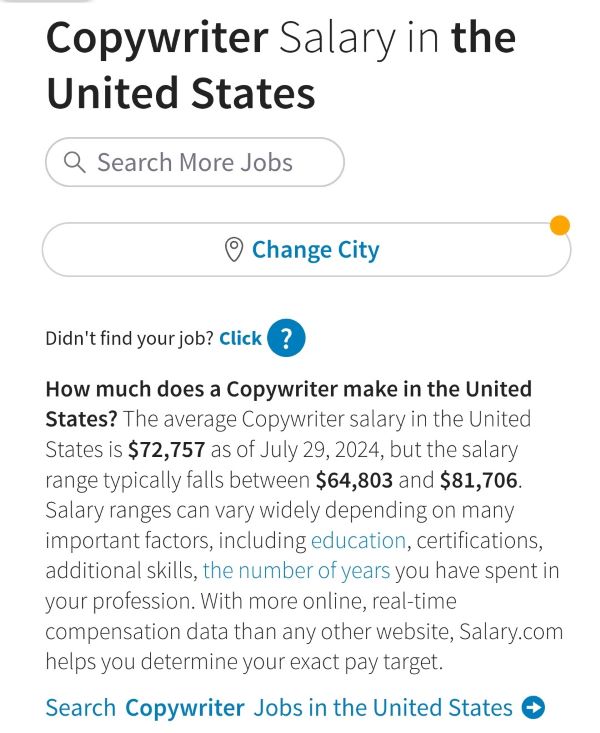
Here’s what the American Writers & Artists Institute (AWAI) has to say.
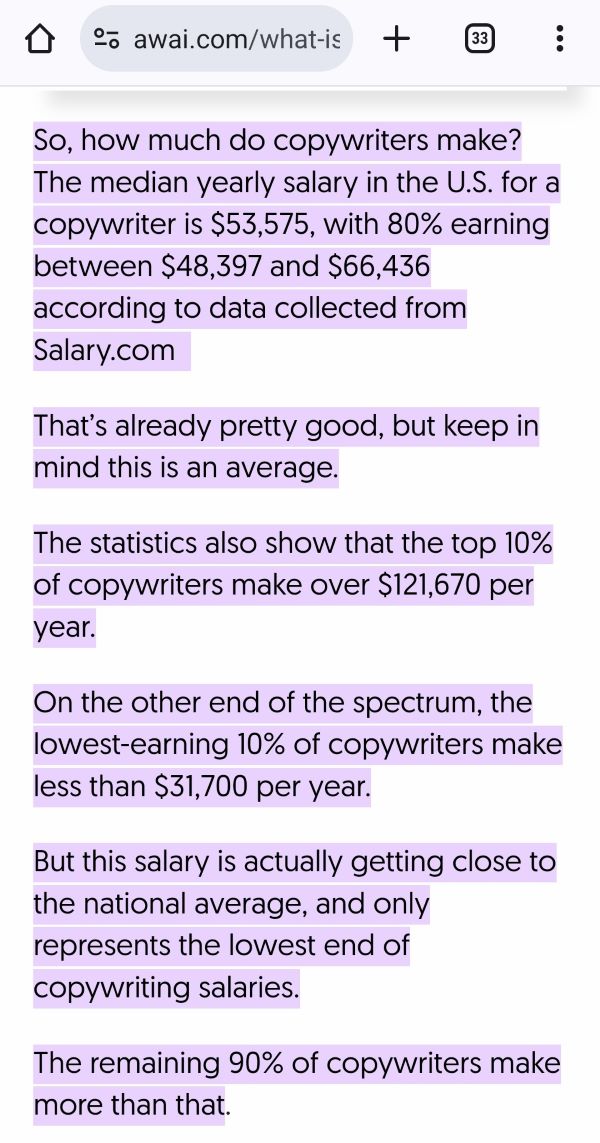
And here’s what The United States Bureau of Labor Statistics has to say about the job outlook for writers and authors (which includes copywriters, according to its definition).
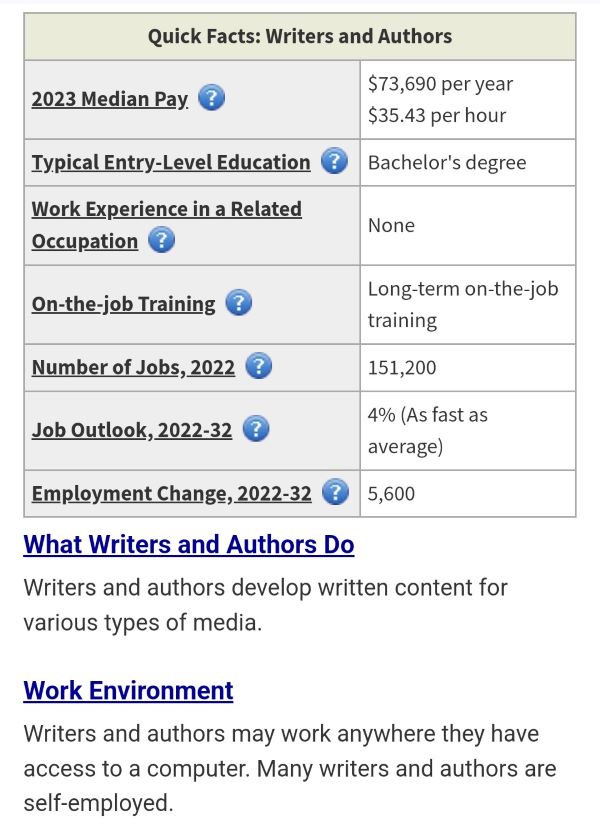
I can’t speak to averages in other countries.
My biggest suggestion if you’re reading this and you’re outside of the U.S. is to network with copywriters, content writers, and marketers in your area (or the nearest major city to where you are).
Yes, one of the nice things about copywriting is that you can do it from anywhere, and it doesn’t matter where the business is located, either. But the reality is often different, right? If English isn’t your first language, you might face challenges breaking into copywriting for US-based businesses. I’m not saying it’s impossible, but it’s an incredibly crowded landscape.
I always advise writers to start local first. How do businesses in your area or your country market themselves? What does the marketing scene look like? Are there any digital marketing agencies in your area? Do the local universities have marketing courses?
Marketing is the big umbrella under which all the various roles—like writers, designers, web developers—often reside, which is why I recommend starting there.
I can only speak about being a copywriter in the US (and one whose first and only language is English).
So, what I’m writing next will be coming from that lens.
If you’re like me and you’re in the U.S. and English is your first language, then keep reading. If not, I highly recommend connecting with copywriters, marketers, etc. in your country. Ask them about their experience, what pitfalls to avoid, and their recommendations for getting started.
Is it hard to become a copywriter?
Saying whether something is hard or easy to do is somewhat subjective. Also, I think the real question is this: is copywriting hard to learn? And the answer is—like so many things in life—it depends.
Do you love to write? Are you a solid writer? Do you understand punctuation and grammar rules (yes, they do matter) and how and when to break those rules successfully? Do you love to read? (Great writers read widely.)
If you answered yes to the above (and I’m talking an honest yes) AND you’re willing to learn AND you’re realistic about how long it will take to learn AND you’re realistic about how long it might take to drum up work or find a job, then yeah . . . it’s not necessarily “hard.”
Learning copywriting takes effort. It takes time. It takes skill. And starting a freelance copywriting business or finding a full-time copywriting gig will take time and effort, too.
There is no shortage of gurus selling courses on how to become a copywriter and make gobs of money seemingly overnight. And I have no doubt that some unicorns exist. Heck, you could be a unicorn.
But for the rest of us—those who are working a full-time job and transitioning into copywriting, those who are interested in learning copywriting but not sure if they have what it takes, or those who are just a bit slower when it comes to launching into something new—it will take time.
Copywriting isn’t crypto. This isn’t something you just do or play around with (like buying low, selling high, and making a huge profit).
Why?
Because copywriting careers are built on relationships, not transactions.
At least, the long-term careers are.
Yes, there are copywriters out there who are more transaction-focused. They write emails or sales letters selling a product or service and have royalty agreements so they get a cut of every sale. You might see these folks on LinkedIn or YouTube touting how much money they’ve made for clients—and themselves.
It’s one approach to copywriting. The copywriters and content writers I know and follow don’t fall into this camp. (The ones I follow and hang with are more like me, freelancers who work with small businesses and agencies.)
I might sound judgmental of the royalty-based approach, but honestly, I’m not. If someone loves doing royalty-based work, that’s great. There’s a place for all of us copywriters, content writers, and content marketers.
What I do have a problem with is people making it sound like that’s the only way to be a copywriter. There are many ways to be a copywriter—that’s just one of them.
And I’m not suggesting that royalty-based copywriters who focus on emails only or direct mail don’t have relationships with their clients. No doubt, they do—especially the ones who’ve been at it a long time.
My concern is this: For folks just entering the copywriting business . . . I’m seeing too many of them get starry-eyed by the numbers. I’m seeing too many folks enter copywriting because they think it’s a fast and easy way to make good money. That’s more of the transactional, crypto mindset I’m warning against.
It’s not sustainable. That’s my hot take, my two cents. Based on private messages I’ve received from struggling writers who took these courses promising fast and steady success and money—only to discover, it’s not as easy as that or worse: They discover they don’t have the chops because they don’t know the basics of writing. (I could be wrong, but I don’t think the folks selling the courses are vetting who’s taking them . . . like, can you pass a basic punctuation and grammar test?)
How to get into copywriting?
OK, I have strong opinions on this. But they’re just that: opinions. There are many paths to Copywriting Land.
Here’s the thing: Everything you need to know about copywriting is free online. You can absolutely teach yourself. But not everyone has the personality for that autodidactic route. I get it. You want a comprehensive course that teaches you what you need to know so you don’t have to waste endless hours cobbling together your education.
I don’t recommend pouring money into courses straight off the bat.
First, ask yourself if you know how to write. Do you understand grammar rules? Do you know how to punctuate? Yes, editors and tools like Grammarly can help you polish your prose, but unless YOU understand the rules first, those tools can’t save you from yourself. (You can try the free version of Grammarly here. That’s an affiliate link; I’ll earn a small commission if you sign up or buy.)
So be honest with yourself. If you’re struggling with the mechanics, start there. (Those are learnable skills.)
Do you enjoy writing? Being a copywriter is like being back in high school or college when you were assigned a term paper—except now, you have those assignments daily. Does that sound awesome to you? Again, be honest.
I think some folks are lured into the idea of copywriting—the freedom to do it anywhere. The ability to set your own rates if you freelance. The giddiness that comes from the idea that you can make money—and maybe even a lot of money—by putting words on a page.
And yet, some of these folks don’t like writing. They don’t want to do the work.
Copywriting takes work. Period. Full stop.
Yes, even with a good AI assistant. (And that’s all ChatGPT is right now. A good tool and assistant. More on AI below.)
If you love to write and are confident in your writing skills, that is GREAT.
You’re ready to learn. There’s no shortage of online courses (paid and free).
Again, I’m a big believer that you can learn everything you need to know for free—or pretty close to it.
I created a free 14-week introduction to copywriting blueprint. This self-directed “course” covers inbound marketing, content marketing, and copywriting basics. I lay it out, but it’s up to you to execute.
You’ll learn about copywriting tips and techniques, copywriting strategy, and how to write effective marketing copy.
I’m embedding the video below. Click through to the YouTube description so you can see the entire course with all the direct links.
I also recommend two books for your Marketing and Copywriting 101 journey. (I’m using Amazon affiliate links. It won’t cost you more if you buy, but I earn a small commission if you do buy. I only link to stuff I believe in.)
✅ The Copywriter’s Handbook by Robert Bly (Amazon affiliate link)
✅ Using Behavioral Science in Marketing: Drive Customer Action and Loyalty by Prompting Instinctive Responses by Nancy Harhut (Amazon affiliate link)
The first book is the one I turned to when I got started in 2002. Bob Bly is a legend. I moved a couple of years ago, and I lost my copy in the process. So, I bought a new copy this year—the improved and fully updated edition.
And Nancy’s book on behavioral science is a GEM because it’s so comprehensive.
How is AI affecting the copywriting landscape?
Ask 20 copywriters about AI and you’ll get 20 different opinions. The one thing I am confident about is this: No one knows with any certainty how AI will affect the copywriting landscape. Certainty only comes in hindsight.
But here’s my hot take as I answer this question in July 2024.
AI is not new, generally speaking.
But widely accessible large language models (LLMs) are, relatively speaking. ChatGPT was the tipping point because it’s the LLM that everyone started talking about back in late 2022 and early 2023 and started playing around with, even if only to experiment for a day or two.
ChatGPT 4o is an excellent tool for many things except writing original content with an authentic voice (even with training). 🙂 That’s where we’re at with it right now. But I suspect ChatGPT will get better with time.
However, and this is a BIG however, ChatGPT isn’t going to replace all human writers.
Sure, some folks will fall away. Honestly? They probably would have anyway.
But the reason I’m not especially worried about AI coming for me is because effective writing involves thinking. It involves understanding nuance. It involves understanding that sometimes breaking a grammar or punctuation rule makes sense because the writing simply sounds better. ChatGPT’s biggest downfall is that it doesn’t think. Also, it’s not proactive.
For example, ChatGPT won’t be privy to the magical conversations you have with clients when they share a random aside, and you’re like, “THAT would make a great blog post, video, social media post.”
Bottom line: ChatGPT needs humans more than we need it.
That said, ChatGPT is a great tool.
Things ChatGPT does well that can help writers:
- Analysis. For example, give it three of your client’s competitors’ websites and have it create a short report on themes, keywords, and opportunities.
- Brainstorming. From blog post titles to email subject lines.
- Outlining. Short-form and long-form content.
- Interview prep. I use it to help develop questions to ask subject matter experts.
- Audience profiles/personas.
- Transcript review/consolidation.
- Feedback. Ask it to provide feedback on your writing.
The challenge is that not every business (even the big guys) will necessarily agree or realize that human writers are still needed. They might think all they need is an AI product. I suspect they will learn the hard way that having an AI tool isn’t enough. It’s a hammer. And you still need someone who knows how to wield the hammer. And even more importantly, you need someone who understands what it takes to build a solid house.
Check out my YouTube playlist devoted to my experiences with ChatGPT and AI.
How to get copywriting clients
If you’re just getting started (and the fact you’re reading this article suggests as much), resist the temptation of worrying about how to get copywriting clients or how to build a copywriting portfolio.
You’re not there yet.
And if you put those things above learning what copywriting is, you’ll likely distract and derail yourself.
I’m not saying you need to put these things on pause for years. But I strongly recommend doing the following first:
- Learning everything you can. Take the time to learn the basics of copywriting, inbound marketing, and digital marketing.
- Networking. Talk to copywriters in your area and ask them about their experiences, pitfalls to avoid, and what they wished they had known when they were starting out.
- Practicing your copywriting skills. My 14-week self-directed copywriting course includes copywriting exercises, like writing headlines.
You might even put your skills to work by offering your copywriting services to friends and family. I can almost guarantee that someone you know owns a small business. Practice what you’re learning by offering to write content for that small business owner: a website page, an email, or a LinkedIn profile. What you do can eventually go into your copywriting portfolio.
But again, start by taking a few steps back and learn everything you can. Be a sponge. That’s my recommendation. It’s not the law.
Some folks have a knack for diving into the deep end and doing well with little experience. If that tends to be you, OK. You know yourself best. You might have luck learning about copywriting and building a copywriting business concurrently.
But be honest with yourself. If that’s not you, you might benefit from taking a breath and a few steps back. (And it might feel less overwhelming in the long run.)
When you are ready to take the next step, I have content that can help:
Got more questions about copywriting?
Check out my YouTube channel or read other articles on my blog.
